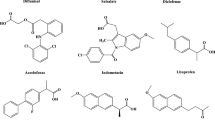Abstract
Gold salts, auranofin (AF), aurothiomalate (ATM) and aurothioglucose (ATG) displayed immunosuppressive action in a series ofin vitro assays which mimic the cell-cell interactions thought to occur in rheumatoid arthritis. The gold salts inhibited phytohaemagglutinin (PHA)-induced thymidine incorporation and γ-IF production by peripheral blood mononuclear cells, as well as IL-2-induced proliferation of PHA-blasts. The separate addition of IL-2 and γ-IF partly reversed the anti-proliferative effects of ATM and ATG; however, the addition of IL-1 had no effect. ATM and ATG inhibited PHA-stimulated IL-1 production by mononuclear cells but not spontaneous or LPS-induced IL-1 production by adherent monocytes. It was concluded that ATM and ATG inhibited lymphocyte function and lymphocyte-amplification of macrophage function.
The anti-proliferative effects of AF were partly reversed by IL-2 but not by γ-IF or IL-1. AF inhibited PHA-stimulated IL-1 production by mononuclear cells as well as spontaneous and LPS-induced production by adherent cells. It appeared that AF inhibited lymphocyte and macrophage function directly. AF also displayed potential anti-inflammatory activity in that it inhibited PGE2 and collagenase production by proteolytically dispersed rheumatoid synovial cells.
Similar content being viewed by others
References
J. Karsh, J. H. Klippel, P. H. Plotz, J. L. Decker, D. G. Wright and M. W. Flye,Lymphophoresis in rheumatoid arthritis, Ann. Rheum. Dis.33, 361 (1981).
H. E. Paulus, H. I. Machleder, S. Levine, D. T. Y. Yu and N. S. MacDonald,Lymphocyte involvement in rheumatoid arthritis, Arth. Rheum.20, 1249 (1977).
P. Larsson, R. Holmdahl, L. Dencker and L. Klareskog,In vivo treatment with W3/13 (anti-pan T) but not with OX8 (anti-suppressor/cytotoxic T) monoclonal antibodies impedes the development of adjuvant arthritis in rats. Immunology56, 383 (1985).
J. Sany, J. Clot, M. Ponneau and M. Andory,Antibodies against HLA-DR alleviate symptoms of rheumatoid arthritis, Arth. Rheum.25, 17 (1982).
P. S. Steeg, R. N. Moore, H. M. Johnson and J. J. Oppenheim,Regulation of murine macrophage I a antigen expression by a lymphokine with immune interferon activity, J. Exp. Med.156, 1780 (1982).
R. C. Newton,Effect of interferon on the induction of human monocyte secretion of interleukin-1 activity, Immunology56, 441 (1985).
K. A. Smith, L. B. Lachman, J. J. Oppenheim and M. F. Favata,The functinal relationship of the interleukins, J. Exp. Med.151, 1551 (1980).
Empire Rheumatism Council Sub-Committee,Gold therapy in rheumatoid arthritis: report of a multi-centre controlled trial. Ann. Rheum. Dis.19, 95 (1960).
H. A. Capell, D. S. Cole, K. K. Manghani and R. W. Morris (Eds.),Auranofin, proceedings of a Smith Kline and French International Symposium, Excerpta Medica, Amsterdam 1983.
J. M. Dayer, S. M. Krane, G. G. Russel and D. R. Robinson,Production of collagenase and prostaglandins by isolated adherent rheumatoid synovial cells, Proc. Natl. Acad. Sci. USA73, 945 (1976).
D. Gordon and G. P. Lewis,Effects of piroxicam on mononuclear cells, comparison with other anti-arthritic drugs, Inflammation, Supp. to8, 87 (1984).
O. Martinez-Maza, U. Andersson, J. Andersson, S. Britton and M. DeLey,Spontaneous production of interferon-γ in adult and newborn humans. J. Immunol. 132 (1), 251 (1984).
L. P. Severdeshy, C. V. Benton, W. H. Berger, E. Rinderknecht, R. N. Harkins and M. A. Palladino,Biological and antigenic similarities of murine interferon-γ and macrophage-activating factor, J. Exp. Med.,159, 812 (1984).
C. A. Dinarello,Interleukin-I, Rev. Infect. Dis.6, 51 (1984).
J. J. Hooks, H. M. Moutsopoulos, S. A. Geis, N. I. Stahl, J. L. Decker and A. L. Nokins,Immune interferon in the circulation of patients with autoimmune disease, N. Engl. J. Med.301, 5 (1979).
P. E. Lipsky and M. Ziff,Inhibition of antigen- and mitogen-induced human lymphocyte proliferation by gold compounds, J. Clin. Invest.57, 455 (1977).
A. V. Haq, D. G. Mayernite, C. Orosz and J. J. Rinehart,Interleukin-1 secretion is not required for human macrophage support of T-cell proliferation, Cell. Immunol.87, 517 (1984).
C. E. Brinkerhoff and P. M. Guyre,Increased proliferation of human synovial fibroblasts treated with recombinant immune interferon, J. Immunol.134 (5), 3142 (1985).
L. Klareskog, U. Forsum and D. Kubelitz,Immune function of human synovial cells: phenotypic and T-cell regulatory properties of macrophage-like cells that express HLA-DR, Arthr. Rheum.25, 488 (1982).
D. R. Green, B. Clive, T. A. Ferguson, K. D. Beaman and P. M. Flood,Production of an antigen-specific component of suppressor inducer factor by a helper T-cell clone: possible role of IL-1 at the interface of immunity and tolerance, Br. J. Rheumat.24, (Supp.), 105 (1985).
P. Scheurich, U. Ucer, M. Killian and K. Pfizenmaier, Differential effects of gamma-interferon on human T-cells during primary activationin vitro. In:Cellular and Molecular Biology of Lymphokines, p. 63. Academic Press, New York 1985.
J. G. Hanley and B. Bresnihan,Reduction of peripheral blood lymphocytes in patients receiving gold therapy for rheumatoid arthritis, Ann. Rheum. Dis.44, 299 (1985).
S. B. Mizel, J. M. Dayer, S. M. Krane and S. E. Mergenhagen,Stimulation of rheumatoid synovial cell collagenase and prostaglandin production by partially purified lymphocyte-activating faction (interleukin 1), Proc. Natl. Acad. Sci. USA,78 (4), 2474 (1981).
D. R. Robinson, A. H. Tashjian and L. Levine.Prostaglandin-stimulated bone resorption by rheumatoid synovia, J. Clin. Invest.56, 1181 (1975).
S. M. Krane, S. R. Goldring and J. M. Dayer,Interactions among lymphocytes, monocytes and other synovial cells in the rheumatoid synovium. InLymphokines, 7, p. 75 (Ed. E. Pick). Academic Press, New York 1982.
Author information
Authors and Affiliations
Rights and permissions
About this article
Cite this article
Barrett, M.L., Lewis, G.P. Unique properties of auranofin as a potential anti-rheumatic drug. Agents and Actions 19, 109–115 (1986). https://doi.org/10.1007/BF01977265
Issue Date:
DOI: https://doi.org/10.1007/BF01977265




